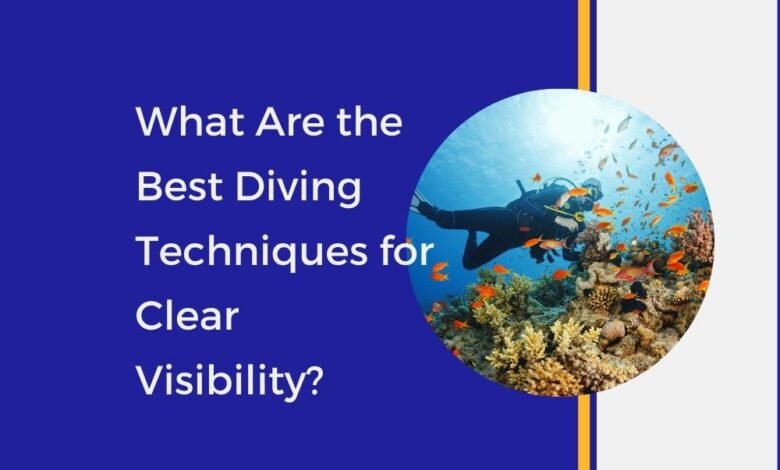
Diving offers an incredible opportunity to explore the underwater world. However, one of the most crucial factors that can affect your diving experience is visibility. Clear visibility allows you to enjoy the vibrant marine life, stunning coral reefs, and underwater landscapes more fully. It also plays a key role in ensuring your safety while diving. Unfortunately, water conditions don’t always provide perfect visibility, and divers often face challenges like murky waters, sand, or plankton in the water. So, what can you do to improve visibility while diving? In this blog, we will cover the best diving techniques that can help ensure you have the clearest visibility possible during your dives.
Understanding the Importance of Visibility in Diving
Clear visibility is essential for a successful and enjoyable dive. It allows you to see everything around you, from small fish to large underwater formations. This not only enhances your experience but also ensures that you can dive safely. Poor visibility can lead to disorientation, difficulty navigating, and even increase the risk of accidents. Therefore, learning the best techniques for clear visibility can make a big difference in your overall diving experience.
One key point to remember is that water clarity can be influenced by several factors, such as weather conditions, water currents, and even the time of year. By understanding these variables and how to adapt to them, you can take the necessary steps to improve your visibility and have a more enjoyable and safer dive.
Note – Experience the thrill of Diving in Fujairah with SeaBreacher for an unforgettable underwater adventure. Explore crystal-clear waters and vibrant marine life. Book your SeaBreacher diving experience today and dive into excitement!
Tip 1: Choose the Right Diving Location for Clear Visibility
One of the most effective ways to ensure clear visibility is to carefully choose your diving location. Certain areas are known for having clearer water than others. For example, tropical destinations often have crystal-clear waters due to the lack of silt or particles in the water. Researching the best diving spots can greatly improve your chances of having a dive with excellent visibility.
In addition, try to avoid locations where water currents stir up the bottom of the ocean, creating murky water. Shallow areas near shorelines with heavy boat traffic or areas with a lot of underwater plants can often result in poor visibility. Instead, aim for deeper, open-water locations where there is less disturbance in the water.
Tip 2: Time Your Dives for Optimal Visibility
The time of day you choose to dive can also impact the visibility underwater. Morning dives tend to offer the best visibility as the water is usually calmer, and there is less sunlight reflecting off the surface. As the day progresses, winds can pick up, creating surface waves that disturb the water and reduce visibility.
In some cases, you may want to plan your dive around the tides. Diving during high tide can lead to clearer water, as the incoming tide tends to bring in cleaner, clearer water from the ocean. Conversely, diving during low tide can result in cloudier water due to the stirring up of particles near the shore.
Planning your dives around these factors can significantly improve your visibility and allow you to enjoy a clearer, more vibrant underwater experience.

Tip 3: Master Your Buoyancy Control for Clearer Visibility
Buoyancy control is one of the most important diving skills you can develop to ensure clear visibility during your dive. Poor buoyancy can cause you to kick up sand, silt, or other particles from the ocean floor, creating a cloud that reduces visibility not only for you but for other divers as well.
To avoid this, practice hovering just above the ocean floor without touching it. By maintaining good buoyancy, you will minimize the disturbance to the seabed, allowing for clearer water around you. If you’re still learning how to control your buoyancy, take your time to master this skill during shallow dives before heading into deeper waters.
By being mindful of how your movements impact the water around you, you can keep your visibility clearer and enjoy a better view of the underwater world.
Tip 4: Use Proper Breathing Techniques
Believe it or not, the way you breathe while diving can affect your visibility. Rapid or shallow breathing can cause you to rise and fall in the water, disturbing the ocean floor and reducing clarity. On the other hand, slow, controlled breathing helps maintain your buoyancy and keeps you stable in the water.
Focus on taking slow, deep breaths through your regulator. This not only helps you conserve air but also allows you to remain calm and steady while diving. When you are in control of your breathing, you are less likely to stir up particles from the seabed, which helps maintain clearer visibility throughout your dive.
Tip 5: Maintain a Slow and Steady Pace
Rushing through your dive can cause unnecessary movement that disturbs the water and reduces visibility. When diving, it’s important to move at a slow and steady pace. Quick movements, such as rapid fin kicks or sudden changes in direction, can stir up particles in the water and create a cloud that obstructs your view.
By maintaining a slow, relaxed pace, you allow the water around you to settle and remain clear. This not only helps you maintain better visibility but also allows you to enjoy the underwater scenery more fully. Take your time and move gently through the water to avoid stirring up sediment or sand.
Tip 6: Position Yourself Upstream from Other Divers
If you’re diving in a group, positioning yourself correctly in relation to other divers can improve your visibility. Divers ahead of you can accidentally stir up sediment, reducing your visibility. To avoid this, try to position yourself upstream from other divers, especially if you’re diving in an area with a lot of sand or silt on the bottom.
If you find yourself behind other divers, give them enough space to allow the water to settle before you swim through it. By being mindful of your position in the group, you can maintain clearer visibility throughout your dive.
Tip 7: Choose the Right Diving Gear
The type of diving gear you use can also play a role in improving visibility. A high-quality mask with a wide field of vision allows you to see more clearly underwater. Make sure your mask fits properly and doesn’t fog up during the dive. Anti-fog sprays or gels can help prevent fogging and ensure that your mask stays clear.
Additionally, choosing fins that provide good control without kicking up sediment is important for maintaining clear water around you. Avoid large, powerful kicks that can disturb the seabed. Instead, opt for smaller, more controlled kicks that allow you to move through the water without creating a cloud of particles.
Conclusion
Clear visibility is key to enjoying a safe and memorable diving experience. By following these tips, such as selecting the right location, mastering your buoyancy, and maintaining a slow pace, you can significantly improve the clarity of the water during your dive. Proper breathing techniques and positioning yourself correctly in a group also play important roles in keeping the water clear.
Remember that visibility can change depending on the water conditions, so always be prepared to adjust your diving technique accordingly. With practice and patience, you’ll be able to enjoy the underwater world with clearer visibility, allowing you to fully appreciate the beauty and wonder of marine life.
For more insightful articles related to this topic, feel free to visit toastul.com


